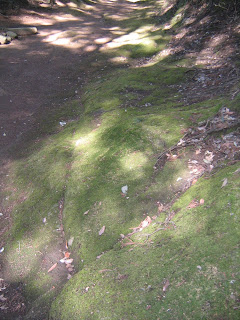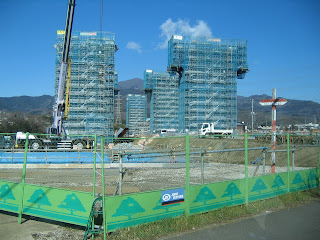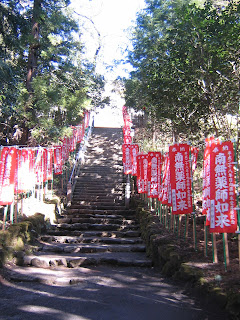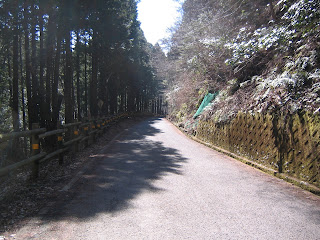… Our beloved and secret forest next to Yokohama Zoorasia has been closed for almost 2 years, to be a venue for the 2017 National Urban Greenery Fair 全国都市緑化フェア. Before, I’ve met grandpas who did allotments for more than 25 years deep within the forest. One of them said “Well, our landlord finally sold his land including our allotments to the City of Yokohama. We must say goodbye to this place … I just wonder what would happen to the pine tree I transplanted from my home village in Tochigi …” Not before long, their place became off-limit for the construction work. On my way to Niiharu Citizen Forest weekends, I watched the marsh where we harvested wild Japanese parsley every early spring was excavated with huge Caterpillars, and old familiar quercus acutissima were chainsawed. I can never bake acorn cookies again from the same trees I collected the ingredients … They were replaced by horticultural cherry trees, surely more flowery than the previous residents. I saw our trekking roads over the wired fence. They were widened and paved … You know, I was apprehensive what’s going on there.
 |
| What’s happening over there? |
The National Urban Greenery Fair is held annually with the money coming from the Ministry of Land, Infrastructure and Transport. This year, City of Yokohama hosts the 33rd melee, called “Garden Necklace: YOKOHAMA 2017.” The venue is composed of 2 areas. The access to the places can be checked here: they have English version as well. One site is around traditional tourism destination of Yokohama, i.e. China Town 中華街 and Yamashita Park 山下公園. The contents of the area are Japanese version of Chelsea Flower Show. Temporary show gardens are constructed in the parks and boulevards with lots of tulips, roses and the latest trend of gardening. Graphic designers are doing some “flower and light show” using iPhones in front of skyscrapers. Lots of horticultural companies sponsored “gardening activities of local school kids in downtown.” I hope you get the idea. Another location is our cherished forest that had hosted Art Exhibition in the Forest of Yokohama 横浜の森美術展 for roughly 10 years. About 2 years ago, the place became off-limit for the construction of the Fair. It’s reopened last Saturday, on March 25, as “Satoyama Garden 里山ガーデン.” To us locals’ surprise, the opening ceremony was held in Satoyama Garden, not in downtown, and the Mayor did the tape-cut in our neighborhood. OK, they thought this place is important, didn’t they …? My father who’s walking in the community daily after his retirement used the forest of art exhibition as a pleasant shortcut to Zoorasia toilets. He’s visited the “Satoyama Garden” this weekend for the first time in almost 2 years. His assessment: “Gosh, the forest became very similar to the garden of Chinzanso Hotel 椿山荘! It’s for lavish wedding parties, not for Satoyama.”
 |
| Municipal
request for not doing Pokemon Go! Inside. |
 |
| Of
course, special souvenir is available in Satoyama Garden. |
I’ve been there too and concluded at least during the carnival it’s not the place to be in nature, but more of very artificial Disney Land … surely for some the place can transport their mind and body to forget a daily life of city, with lots of pansies, roses, and (needless to say) cherry blossoms … But Satoyama was not a dream world. It was the place our ancestors built the tradition of ordinary Japanese life … What’s the purpose of this destruction? So I wondered for a while in my stroll of the venue …
 |
| The former
place of “Spirit of Tree” is now the main gate for the Fair where shuttle buses and “Park Train” are coming. |
 |
| Park
Train is an electric car pulling wagons for passengers. “200 yen, one way.” You don’t have to walk at all within the forest, then. Spirit of … what? |
 |
| At the
end of Yato 谷戸 swamp, there were totem poles. This one, |
 |
| This one, |
 |
| And
this one. One of my fellow trainees of Kanagawa Forest Instructor was in a team of elementary school kids who made these spirits of forest. |
 |
| The
place is now for a “Suggestion of sophisticated modern room with comfortable sofas and wide-opened windows to the nature. Please limit your usage of the sofa for max 30min. Thank you.” |
The place where local grandpas had allotments is now for “Grand Flowerbed of Yokohama 横浜の花で彩る大花壇.” There was no trace of a pine tree at all, even a stump. Knowledgeable elderly people were discussing the differences in types of tulips planted neatly in the former leek field. Girls in mini-skirts were taking selfies with their friends and colorful daisies. Professionally mowed lawns are strategically placed within the flowerbed as “Picnic Fields.” A guy surrounded by young parents explained, “When you let your baby learn to walk barefoot on lawns, it will stimulate the development of brain very well. So it is highly advisable to bring your kid regularly to the environment like this …” Next to the group for a lecturer, a smiling mom and a toddler kid had a lunch of savory pastries picking from a bag of famous downtown bakery while their dad lay beside and completely fell into a deep sleep … he must have been very tired … The 4/5 of roads within the venue are paved. Er, OK, barrier-free zones, are they? I’ve met several families in the remaining 1/5 of former trekking road in dirt. They were at loss for the way to go through with their baby strollers or polished but slippery leather shoes. “Shit, why haven’t they paved this road!?” A curse of a dad.
 |
| Surely, they are beautiful. |
 |
| And good for child development. |
 |
| Before there were allotments … |
 |
| One of
the “unpaved” part … hmmm, yeah, it’s not so suitable for strollers. But then, why did they think they could proceed in their attire? |
The former ridge way where there were art installations for bagworm (endangered species in Yokohama) is now the main street of Satoyama Garden where Park Train operates. From the main entrance of shuttle bus terminal, the first attraction on this street is “Forest Adventure” imported from France. There was a long line to make a reservation. A group of 3 small girls, maybe 8 or 9 years old, eagerly joined the line, giggling excited. The next fun was named “Glamping Site” in a former meeting place for GROUP the Creation and Voice of the Woods 創造と森の声. The space is now equipped with a large and clean wood deck for “experiencing camp fires,” slack lines (“The world #3 athlete for slack line competition will perform his exhibition on April 1st and 2nd!”), hammocks, glamping tents, and inevitable MORI café serving meals made of ingredients from Yokohama. I was astonished to hear the announcement over speakers: “For you having numbered ticket for 11:30 experience session of boiling water over the camp fire, the gate is now open.” The tickets for log cutting were fetched rapidly. Kids were laughing in glamping tents …
 |
| Surely, it looks exciting. |
 |
| Before the site was like this … |
 |
| For you to boil water … |
 |
| “You
can cut logs!” Er, well, please come and join us Niiharu Lovers. We’re doing it every weekend. |
 |
| Glamping tents |
 |
| MORI
café. Their menu includes latte, herb teas, artisan beers, organic salads, ham and cheese steaks … Afogatos are available as dessert. |
 |
| But it was a quiet place before … |
The marsh where we collected Japanese parsley is now for professionally placed irises and rape blossoms. I found they thinned aggressively wild Cerasus jamasakura, and planted cloned horticultural cherries from “famous trees” in Gifu and the other prefectures … I don’t say we should have built the wall, but … why did they have to cut our local trees? Because they were ordinary? But Satoyama is for ordinary, nothing special, peaceful life, isn’t it? Then, something occurred to me. The majority of people in Metropolitan Tokyo genuinely do not know what is Satoyama, or even how to walk in a natural forest. They honestly need to experience boiling water over log fire, or stand near to a tree even if their ground is not a real organic soil. If they find it’s a fun to be in a “forest,” they may try one without Park Train later. Our forest was chosen to be an entrance for them to experience nature. They need some famous attraction to begin, and our ordinary Satoyama trees were martyred for that. Oh my …
 |
| Surely,
it’s catchy and beautiful … Two years ago this time, over there looked like in the pale-pink mist of flowers of wild Cerasus jamasakura, blossoming quietly … |
 |
| A
clone of some famous cherry tree coming from elsewhere. |
I asked one of the ushers of the event if they know the whereabouts of totem poles and sculptures resided in the forest before the construction. After roughly 15 minutes’ enquiry, he said they may be stored in a warehouse in the off-limit area of Satoyama Garden. The Fair is for March 25 – June 4, 2017. He explained after the fête equipment will be removed and the roads are to be reorganized for permanent botanical park of Zoorasia. At that time, those previous installations could be returned, or might be … I found several stumps along a dirt road within the scene. They have already started to regenerate with lots of young sprouts, typical for after coppicing. The forest in Yokohama may not be so “gorgeous,” but strong. They could be embarrassed by my sentimental mourning. I felt like being encouraged. The forest is saying “So What?”
































